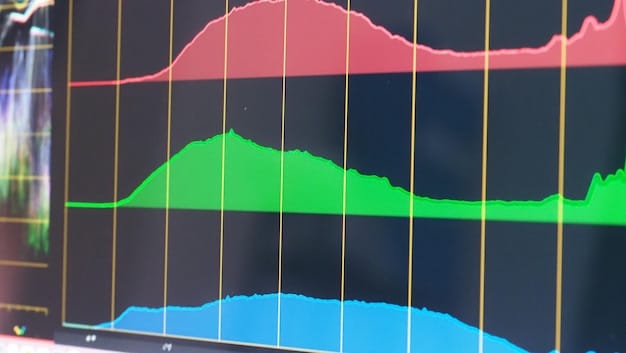The 3-Month Rule: Your Guide to Scoring the Best Deals

The 3-Month Rule is a simple yet effective strategy for tracking prices on your desired items, allowing you to identify price drops, understand seasonal trends, and ultimately snag the best deals on everything from electronics to fashion.
Want to score amazing deals but tired of constantly checking prices? The 3-Month Rule is your secret weapon. This straightforward strategy helps you track price fluctuations, understand shopping seasons, and finally snag those wishlist items at their lowest possible price.
Understanding the 3-Month Rule
The 3-Month Rule is a straightforward approach to price tracking. It’s based on the idea that most products experience price fluctuations over a relatively short period. By monitoring these changes, you can identify the best time to buy.
This method is particularly useful for items that aren’t urgent purchases. Let’s delve deeper into why this strategy is so effective and how it can transform your shopping habits.
Why 3 Months?
Three months provides a reasonable timeframe for observing price trends. This duration allows you to capture seasonal sales, promotional events, and typical price adjustments that tend to occur within this period.
It’s long enough to avoid being misled by short-term price spikes but short enough for the data to remain relevant. This balance ensures you make informed decisions based on meaningful patterns.
Benefits of Using the 3-Month Rule
- Saves Money: By buying at the lowest price point within the 3-month window, you can save a significant amount of money on your purchases.
- Reduces Impulse Buys: This method encourages thoughtful purchasing, reducing the likelihood of buying impulsively only to find the item cheaper later.
- Helps Budgeting: Knowing potential price ranges can aid in budgeting and planning when to make specific purchases.
- Easy to Implement: This rule is simple to understand and put into practice, requiring minimal time and effort.
In summary, the 3-Month Rule is a practical and efficient method for smarter shopping. By tracking prices for a set period, you gain insights that can lead to significant savings and more informed purchasing decisions.

How to Track Prices Effectively
To implement the 3-Month Rule effectively, you need a reliable method for tracking prices. While traditional methods like manually checking websites work, several tools and apps make the process much easier.
Let’s explore some of these techniques to help you monitor price changes with minimal effort and maximum efficiency.
Utilizing Price Tracking Websites
Several websites are designed specifically for tracking prices. These platforms allow you to enter the product you want to monitor, and they will automatically track its price across various retailers.
Popular options include CamelCamelCamel (for Amazon) and Google Shopping. These sites provide historical price data and can send you alerts when the price drops below your desired threshold.
Leveraging Shopping Apps
Shopping apps are another convenient way to track prices. Many apps, such as ShopSavvy and PricePirates, allow you to scan barcodes or search for products to find the best deals.
These apps often include price tracking features that send you notifications when there are price changes, ensuring you never miss a potential saving.
Manual Price Tracking with Spreadsheets
If you prefer a hands-on approach, consider manually tracking prices using a spreadsheet. While this method requires more effort, it gives you complete control over the data.
Create columns for the product name, retailer, date, and price. Update the spreadsheet regularly to monitor price fluctuations over the 3-month period.
- Be Consistent: Choose a tracking method and stick with it to maintain accurate and comparable data.
- Set Price Alerts: Use price tracking tools to set alerts, so you don’t have to constantly check for price drops manually.
- Document Everything: Whether manually or automatically, keep detailed records to spot trends and patterns.
Effectively tracking prices takes discipline, but the time invested can lead to significant savings. By utilizing these methods, you empower yourself to make informed purchasing decisions.
Setting a Target Price
One of the biggest advantages of the 3-Month Rule is that it allows you to set a target price. This critical step keeps you from overpaying and ensures you strike when the price is right.
But how do you determine what a good target price is? Here, we’ll explore how to establish realistic and achievable target prices by analyzing historical data, considering your budget, and accounting for sales events.
Analyzing Historical Price Data
Before setting a target price, research the historical price data for the item. Price tracking websites and apps often provide charts showing how the price has changed over time.
Look for patterns such as seasonal lows or recurring sales to inform your target price. Understanding past price trends helps you set a realistic goal.
Considering Your Budget
Your budget is a primary factor in determining a target price. Assess how much you are willing to spend on the item and set your target price accordingly.
It’s wise to set a maximum price you won’t exceed, even if it means waiting longer for a better deal. Be firm about sticking to your budget to avoid overspending.
Accounting for Sales Events
Specific times of the year, such as Black Friday, Cyber Monday, and seasonal clearances, often bring significant discounts. Factor these events into your target price strategy.
If you are willing to wait for a major sale, set your target price to reflect the potential discounts available. Keep an eye on retailers’ past sales to estimate potential price reductions accurately.

- Be Specific: Set an exact number rather than a vague range to stay focused.
- Be Patient: Waiting for your target price may take time, so be prepared to delay your purchase.
- Stay Flexible: Occasionally, adjust your target if market conditions or the item’s availability change significantly.
Setting a target price is an essential component of the 3-Month Rule. Analyzing historical data, considering your budget, and accounting for sales events will help you define a practical target price that saves you money and respects your financial plan.
Identifying Sales and Discounts
One of the best aspects of using the 3-Month Rule is that it helps you pinpoint sales and discounts. Sales events often have predictable patterns, and by monitoring prices, you can take advantage of these opportunities.
Let’s examine the different types of sales events, how to predict when they might occur, and which ones usually provide the best deals.
Types of Sales Events
Various sales events occur throughout the year, each with its own characteristics. Common events include seasonal sales, clearance events, and promotional sales tied to holidays or specific products.
Understanding the characteristics of each type helps you determine the best time to buy specific items. For example, summer clothing might be heavily discounted during end-of-season clearance sales.
Predicting Sales Event Timing
Many sales events occur at predictable times each year. Retailers typically follow established patterns, such as back-to-school sales in late summer and holiday sales in November and December.
By analyzing past sales trends, you can anticipate when specific discounts are likely to surface. Sign up for retailer newsletters and follow them on social media to receive early announcements of upcoming sales.
Which Ones Offer the Best Deals?
Different sales events offer varying levels of discounts. Black Friday and Cyber Monday are often touted as having the steepest markdowns, but seasonal clearances and smaller promotional sales can also provide excellent deals.
Evaluate the typical discounts offered during each event based on historical data and compare them to your target price. Sometimes, smaller sales offer better savings than hyped events.
- Research Past Trends: Analyze how prices have fluctuated during past sales events to predict future trends.
- Sign up for Alerts: Keep track of when sales are about to start.
- Consider All Events: Assess discounts during various events to identify the most beneficial opportunities for your target item.
Mastering sales event patterns through careful observation and analysis sets you up to seize optimal discounting. Taking that action adds critical insight to improve your mastery and budget savings using the 3-Month Rule.
Potential Pitfalls and How to Avoid Them
While the 3-Month Rule is a useful strategy for saving money, it’s not without its potential pitfalls. Knowing these challenges and how to overcome them ensures your approach remains effective.
Now, we’ll explore the common issues, such as missing a deal, accounting for product obsolescence, and managing price fluctuations.
Missing a Deal
One risk of tracking prices over an extended period is the possibility of missing a limited-time discount. Prices can drop unexpectedly, and you need to be vigilant to seize these opportunities.
Set up immediate price alerts and check product pages daily to minimize the chance of missing a deal. Make sure to act quickly when your target price is reached because these deals can sell out fast.
Accounting for Product Obsolescence
Products, especially technology items, can become outdated quickly. Tracking a price for too long might mean buying an obsolete product when newer, better options are available.
Consider the lifecycle of the product before you begin tracking. If it is a fast-evolving item, set a shorter tracking period or be prepared to adjust your strategy if a newer model is released.
Managing Price Fluctuations
Prices don’t always move in a downward trend; they can fluctuate significantly. These fluctuations can be misleading and make it challenging to determine the “best” time to buy.
Focus on long-term patterns, not short-term blips. Use historical data to understand the general price range and set realistic expectations. Do not be discouraged by temporary price increases and stick to your target price.
- Set Realistic Expectations: Understand that prices may fluctuate, and be ready to adjust your strategy if necessary.
- Stay Informed: Keep up-to-date with product releases and industry news that may affect prices.
- Be Decisive: When your target price is reached and the product is still relevant, act quickly to avoid missing the deal.
Being aware of these problems increases the success of your application of the 3-Month Rule. You will make better decisions for improved satisfaction and savings.
Real-Life Examples and Case Studies
To truly understand the power of the 3-Month Rule, let’s look at some real-life examples and case studies illustrating how it can be beneficial. These stories show practical applications to help you see how you can use these methods yourself.
Let’s explore different scenarios where following this strategy led to significant savings and better purchasing decision.
Electronics Purchase
Sarah wanted to buy a new laptop but wasn’t in a rush. She tracked the laptop’s price for three months, noticing a gradual decline broken by a few temporary price spikes.
During a promotional tech sale, the price dropped to her target, but Sarah almost hesitated based on recent increases. Fortunately, she followed the historical data and purchased the laptop at a 20% savings versus the initial price.
Fashion Items
Mark wanted a specific designer jacket. He used the 3-Month Rule to track its price, and noticed the jacket was consistently high for the first month, but then decreased.
He learned the retailer had seasonal clearance sales and waited for the clearance sale where he purchased it at a 30% discount. This saved him a tidy amount of money compared to buying the jacket at full price.
Home Appliances
Lisa needed a new refrigerator and started tracking prices to get the best deal. She found out major appliances were on sale in September and October, just before the cold seasons began.
With this knowledge in hand, Lisa bought her refrigerator. Thanks to the seasonal discount, Lisa kept her house up to date, remained under budget, and was happy.
- Be Focused: Staying focused will lead to the best results.
- Be Consistent: Consistency matters in this game, you must be consistent to have a better shot.
- Keep Up to Date: Make sure to keep up with current trends to be successful.
The impact of the 3-Month Rule is seen clearly in these instances. By following the principle, it shows you the impact that can be made by tracking prices and buying on a determined budget.
| Key Point | Brief Description |
|---|---|
| 💰 Price Tracking | Monitor prices for 3 months to identify trends. |
| 🎯 Setting Target Prices | Determine a realistic price based on historical data and budget. |
| 🗓️ Identify Sales | Anticipate and leverage seasonal and promotional sales. |
| ⚠️ Potential Issues | Avoid missing deals, obsolescence, and price fluctuations. |
FAQ
▼
The 3-Month Rule involves tracking the price of an item you want to buy over a three-month period to identify price trends. This helps you determine the best time to purchase it at the lowest possible price.
▼
Start by identifying the product you want to track. Use price tracking websites, shopping apps, or create a manual spreadsheet. Note the initial price and then monitor changes over the following three months.
▼
If the price remains high, consider extending your tracking period or re-evaluating your target price. Also, check for upcoming sales events or look for similar products that may be more affordable.
▼
The 3-Month Rule is most effective for non-essential items where you have flexibility in timing. It’s less suitable for urgent needs where quick purchases are necessary, regardless of price.
▼
Ideally, check prices at least once a week to get a good sense of trends. Set up price alerts for automatic notificatons. Consistent monitoring ensures you dont miss out on potential deals.
Conclusion
The 3-Month Rule is your ticket to budget-friendly shopping. With consistent price tracking, sales anticipation, and flexibility, you can score the best deals. So, embrace this method and revolutionize your purchasing.





